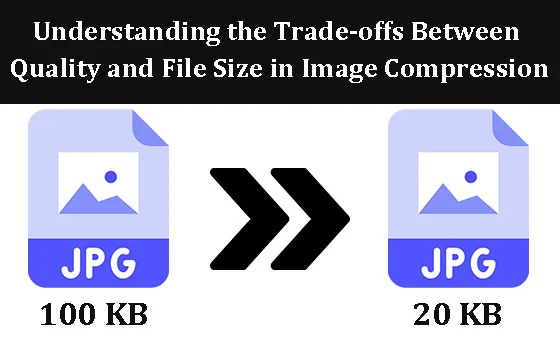Introduction
In the fast-paced digital era, where visual content dominates online spaces, image compression plays a vital role in optimizing file sizes for efficient storage, faster transmission, and improved user experience. However, the process of compression involves inherent trade-offs between image quality and file size. This comprehensive guide delves into the intricacies of image compression, exploring the challenges, techniques, and the delicate balance between preserving visual fidelity and minimizing file sizes.
The Basics of Image Compression
1.1 What is Image Compression?
Image compression is the process of reducing the file size of an image while attempting to preserve its visual content. This is achieved by removing redundant or unnecessary data, making the image more manageable for storage, transmission, and display on various devices.
1.2 Importance of Image Compression
Compress jpeg to 100kb is crucial for various applications, including web development, mobile apps, and medical imaging. It not only saves storage space but also facilitates faster loading times, conserves bandwidth, and contributes to a seamless user experience.
Types of Image Compression
2.1 Lossless Compression
Lossless compression retains all original data, ensuring that the decompressed image is identical to the original. This type of compression is ideal for scenarios where preserving every detail is paramount, such as in medical imaging or graphic design.
2.2 Lossy Compression
In contrast, lossy compression sacrifices some level of detail to achieve higher compression ratios. This method is widely used in applications like web development, where small file sizes are prioritized over absolute image fidelity.
The Trade-offs: Quality vs. File Size
3.1 Quality Considerations
Image quality is a subjective measure that encompasses factors such as clarity, sharpness, and color accuracy. Maintaining high quality is critical in applications like photography, where visual aesthetics are of utmost importance.
3.2 File Size Considerations
File size directly impacts storage requirements, bandwidth usage, and loading times. Smaller file sizes are advantageous for websites, mobile applications, and platforms where optimizing speed and resource usage is a priority.
Challenges in Image Compression
4.1 Preserving Fine Details
One of the primary challenges in image compression is preserving fine details, especially in intricate images or photographs. Lossy compression methods must strike a delicate balance to avoid noticeable degradation.
4.2 Avoiding Compression Artifacts
Compression artifacts, such as blockiness, blurring, or color distortions, can occur during the compression process. Minimizing these artifacts is crucial for maintaining image integrity.
4.3 Adapting to Different Image Types
Images come in various types, from simple graphics to complex photographs. An effective compression algorithm should adapt to the characteristics of different image types, ensuring optimal results across the board.
Techniques in Image Compression
5.1 Run-Length Encoding (RLE)
RLE is a basic form of lossless compression that works by encoding consecutive identical pixels as a single value and a count. While simple, it is effective for certain types of images. Further, there is an online tool named Dezgo that may help you extract text from images after compression.
5.2 Discrete Cosine Transform (DCT)
DCT, commonly used in JPEG compression, transforms image data into frequency components. It allows for variable compression ratios, but care must be taken to avoid perceptible quality loss.
5.3 Wavelet-Based Compression
Wavelet-based compression divides an image into frequency components, enabling selective compression. This technique is powerful for preserving details while achieving significant compression.
5.4 Vector Quantization
Vector quantization involves grouping similar blocks of pixels and representing them with a single value. This technique can be employed in both lossless and lossy compression methods.
The Future of Image Compression Technology
6.1 Artificial Intelligence and Machine Learning Integration
The future of image compression holds promise with the integration of artificial intelligence (AI) and machine learning. AI algorithms can learn intricate image patterns, leading to more efficient and adaptive compression methods.
6.2 Blockchain for Image Integrity
Blockchain technology may play a role in ensuring the integrity of compressed images. By creating a decentralized and tamper-proof record of compression processes, blockchain can enhance trust in the authenticity of compressed images.
6.3 Improved Compression Algorithms for Specific Applications
As technology advances, we can expect the development of specialized compression algorithms tailored for specific applications. Industries like virtual reality, augmented reality, and medical imaging may see advancements in compression techniques catering to their unique needs.
Striking the Right Balance
7.1 Adaptive Compression Strategies
The future of image compression lies in adaptive strategies that can adjust the compression level based on the specific needs of each image. This ensures that critical details are preserved while non-essential elements are efficiently compressed.
7.2 User-Defined Compression Preferences
Allowing users to define their compression preferences could become a norm. Platforms and applications may provide settings that let users choose the compression level based on their priorities—be it image quality or file size.
7.3 Dynamic Compression for Responsive Applications
Dynamic compression that adapts in real-time to network conditions and user devices is a key area for future development. This ensures optimal image quality and loading times based on the user's context.
Ethical Considerations in Image Compression
8.1 Informed Consent and Transparency
As image compression becomes more sophisticated, ethical considerations surrounding informed consent and transparency become crucial. Users should be informed about the compression process, and platforms should be transparent about the level of compression applied.
8.2 Medical Imaging and Diagnostic Confidence
In medical imaging, maintaining diagnostic confidence is paramount. Ethical considerations in image compression include ensuring that compression methods do not compromise the accuracy of medical diagnoses.
Conclusion
In conclusion, the trade-offs between quality and file size in image compression represent a delicate balance that continues to evolve with technological advancements. As we navigate the future of image compression technology, the challenge lies in developing methods that can adapt to diverse applications while addressing ethical considerations. The journey toward achieving optimal image compression continues, shaping how we store, transmit, and experience visual content in the digital age.

